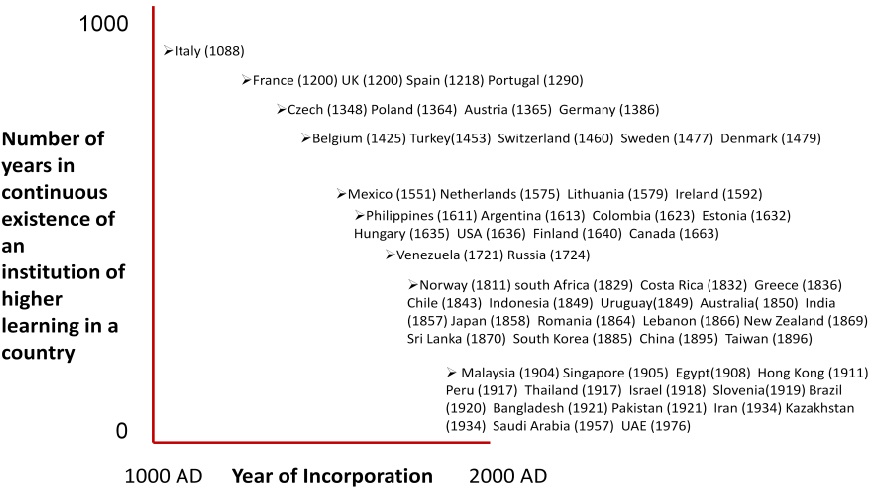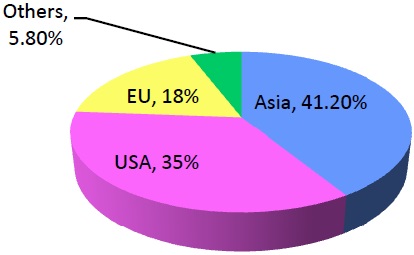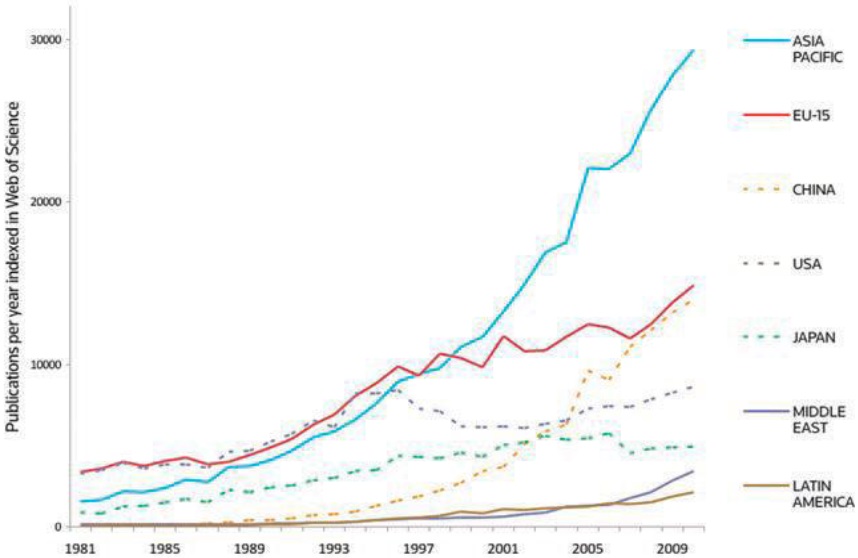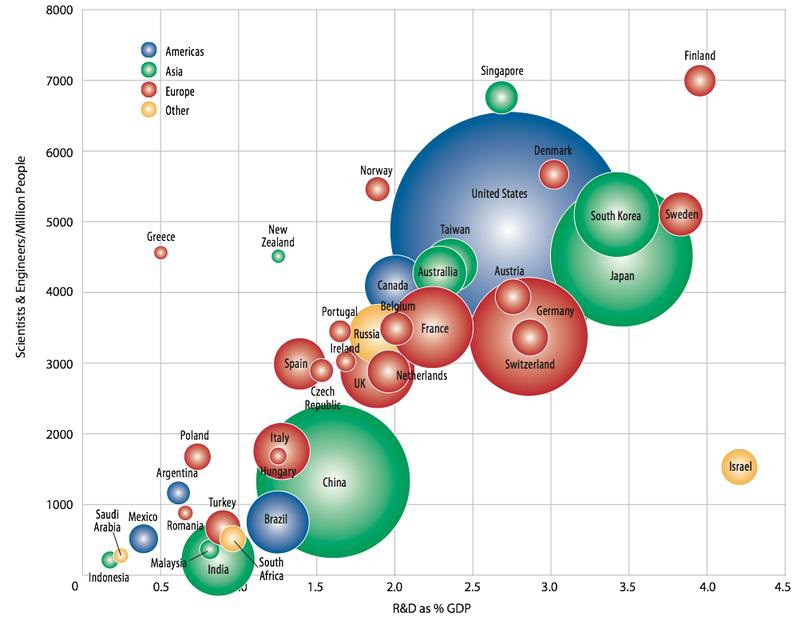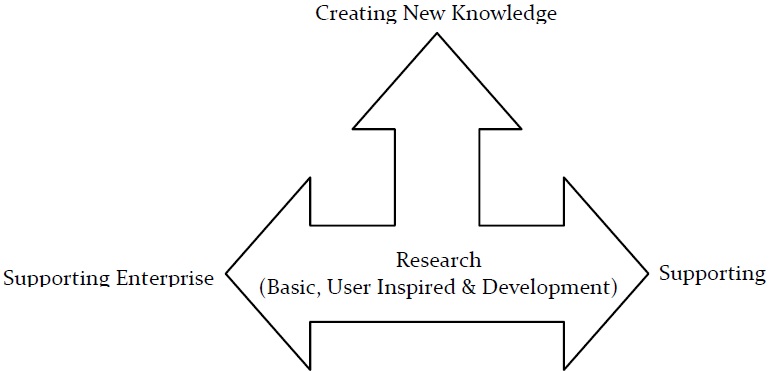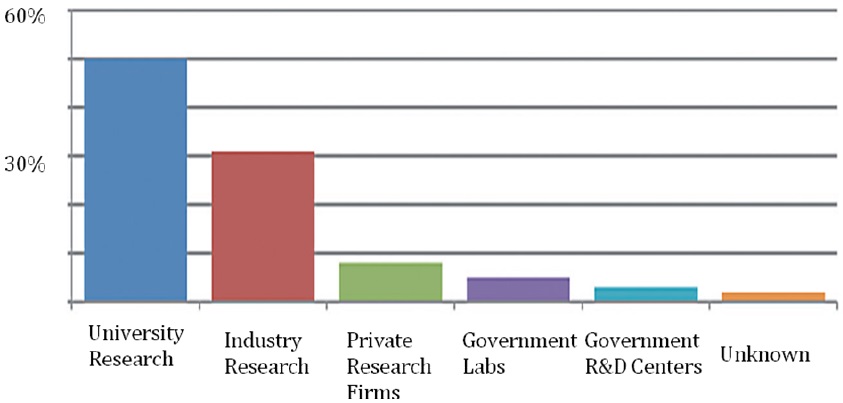



Asia is becoming a stronghold for innovation careers along with its resurgence in economic, political, and cultural arenas. This transformation happened on the backdrop of growing enrolments in higher education, increasing investments in scientific research & innovation, and innovation supportive policy measures by several Asian countries. Research and Development (R&D) and product customization centres of multinational corporations (MNCs) sited in emerging nations are also instrumental in this transformation.
We live in a world with growing number of choices. When you pose the next generation a question
The generations born in 1950s, 60s, and 70s felt that there were not enough opportunities to pursue innovation careers in Asia. Hence they went to the USA and West European countries, who are super powers in scientific research led innovations. Over the years it has been recognised that innovation is critical to driving growth in developed as well as emerging economies. Now the world total R&D investments exceed a trillion dollars. Since 2000s several emerging nations, primarily in Asia, have been investing in scientific research and innovation thereby increasing respective innovation capabilities and capacities. In the hyper-connected, interdependent, fast paced, collaborative, and competitive global world, Asia has become a stronghold for innovation careers.
Recent announcement by an Australian billionaire to engage the Nanjing-based CSC Jinling Shipyard to build the iconic Titanic II is no surprise. Asia has become a test bed for creative and innovative ideas, as can be evidenced from the implementation of various technically advanced and challenging projects. In other words the risk appetite of Asia has grown over the years. Access to local as well as international resources and expertise which facilitate innovation and entrepreneurial activities is more now in Asia than previous decades.
The reminder of the manuscript examines various key enablers, influencers and spoilers of Asia becoming a place of choice for innovation careers. Also innovation strategies are suggested for aspiring countries to become innovation hubs and to realize sustained economic growth and well being of people.
1. Asia is home to major ancient civilizations of the world who contributed to the earlier inventions of humankind such as compass, gun powder, paper making and printing, seismograph, silk and embroidery, grand canals for water supply, mathematics, precious metals, immunology, and cosmic knowledge. In other words Asian culture is conducive to innovations.
Societal challenges and urbanization, supported by growing economic wealth, are creating fertile conditions such as need, capacity and capability for innovation in Asia.
2. Aided by growing personal affluence, affordable air fares and easy connectivity, and curiosity, in recent years, large numbers of Asians have travelled to all corners of the world. They have experienced the best practices in other parts of the world. In addition the widespread penetration of modern social media which includes mobile phones, internet, and television and radio programs delivered in respective native languages has enabled vast populations of Asia to learn and appreciate advanced practices of developed nations. Transformed Asians are confident that they are capable of inventing and shaping own destinies instead of assuming them to be pre-determined. There is a shift from non-material aspirations to material aspirations.
3. Asia is home to majority of world’s youth. Modern higher education is relatively new in Asia (see Figure 1). As Asian nations pursue the goal of mass higher education, increased proportion of talented, motivated, and hardworking youth are exposed to higher learning compared to the earlier generations. This is contributing to the growing capacity and capabilities for innovation in Asia.
4. Asians have high affinity towards modern products. More importantly the youth are strongly motivated to own high-technology goods with innovative features. This nature enables them to be savvy and comfortable with high technology innovations.
5. Emerging nations, majority of which are in Asia, are now responsible for 40% of the high technology manufacturing output of the world (see Figure 2). And 25% of total manufacturing of the world is high-technology manufacturing. In recent decades the share of emerging nations in the world economy has increased from less than 20% to ~50%.
6. About 60% of the world’s population resides in Asia. According to forecasts this proportion will remain unchanged as the world population grows from current 7 billion to 9 billion by 2050. Asia’s share of global GDP is nearly 50%. In the coming decades this share is projected to go up to 75%, thereby Asia possessing the economic muscle to innovate and shape the future. For example, by 2016 China is projected to surpass USA in terms of purchasing power parity GDP.
7. Assisted by growing wealth and necessities imposed by national challenges, Asian nations are taking the risks and becoming pioneering test beds for innovative solutions. This creates a virtuous cycle of implementation of innovative solutions and resources to support research and innovation, and thereby develop new innovations. For example, many green field projects in Asia are adopting more energy-efficient and environmentally-friendly standards in the construction of new buildings and cities, power generation plants and manufacturing industries. Given the economic and market sizes of certain Asian nations, they are likely to set new benchmarks which will influence the success of future innovations.
[Table 1] Asia tops the share of R&D investments (Ref: Battelle 2012 R&D Report)

Asia tops the share of R&D investments (Ref: Battelle 2012 R&D Report)
8. In year 2012, the R&D investments of Asia have surpassed the investments by USA and European countries (see Table 1). One of the outcomes is increased number of peer reviewed scientific publications coming out of Asia compared to any other region of the world (see Figure 3)
9. 20th Century saw the migration of critical mass of talented scientists and innovators of Western Europe and rest of the world to USA which benefited it immensely. Economic slowdown in USA and Western Europe and growing opportunities in Asia are drawing talents. Asia is poised to benefit from the returning talents who are educated and trained in world’s best universities in USA and Europe, and continue to maintain strong ties with their alma maters and contacts. This provides a unique opportunity i.e. Asia and Western World can partner strategically in the generation of new knowledge and innovative solutions to common societal challenges such as clean water, energy, and environment, affordable healthcare and security.
10. Most of the recent growth in the total global workforce for research and innovation happened in Asia. Hence a large number of Asians are involved in the process of innovation (Table 2).
[Table 2] Geographical distribution of researchers (Ref: Changing Face of Innovation)
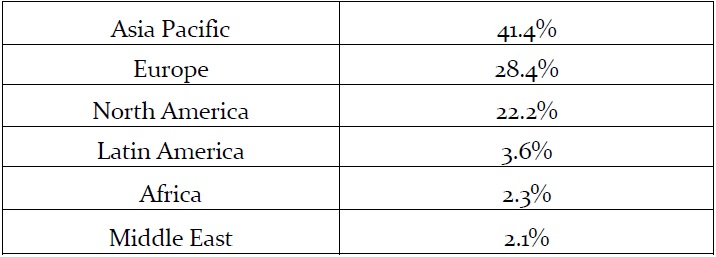
Geographical distribution of researchers (Ref: Changing Face of Innovation)
11. In recent years, the level of investment in research and innovation expressed in % of gross domestic product (GDP) by Japan, Singapore and South Korea are comparable to those by USA, Germany, UK, France, Canada, Netherlands, Switzerland, Sweden, Denmark, Norway, and Finland (see Figure 4). China embraced innovation to ensure sustainability of its economic growth, and ramping up the investments in research and innovation and upgrading various institutions. India as well as several ASEAN and Middle Eastern countries are also investing to encourage innovation in various sectors of respective economies.
12. Asia is expanding the university sector with the goal of enhancing the age cohort participation rate from 20% to 40%. Asian countries are also nurturing diverse higher learning institutions such as research-intensive universities, teaching universities & colleges, and technology and industry oriented universities & colleges. Such diverse human capital is essential for sustaining the value chain of innovation.
[Table 3] Programs aimed at building world class universities

Programs aimed at building world class universities
13. Asian countries also realised the importance of research-intensive universities and their close interactions with the innovation hubs or science & technology parks in building the nation’s capability and capacity for innovation and in growing high value add industries. Table 3 lists targeted efforts of various Asian countries in building respective world class universities.
14. Access to scientific literature via high speed internet and digital media has hastened the process of absorption of new knowledge in Asia thereby contributing to enhanced innovation opportunities. Research community of Asia is well connected to the peers in advanced countries and rest of the world. Such openness and broader access to knowledge are important enablers of Asia’s strong participation in research and innovation endeavours.
15. Multinational companies have further expanded and deepened their design and innovation operations in Asia to leverage on the local talent, innovation supportive policies and market opportunities thereby reducing the cost of productization and accelerating pace of innovation in Asia. Companies are practicing open innovation strategies as it is possible now to hire anywhere, source investments anywhere, design anywhere, build everywhere and market anywhere. Open sourcing and integrative practices of multi-national companies are also key enablers of Asia’s growing presence in the global research and innovation landscape.
Helmut Traitler, Vice President for Innovation Partnerships at Nestle aptly summarised the potential of open innovation as ‘Nestle clearly recognizes that to achieve its growth objective it must extend its internal capabilities to establish a large number of strategic partnering relationships. It has embraced open innovation and works aggressively with strategic partners to co-create significant new market and product opportunities. Worldwide, Nestle employs approximate 5,000 people in 24 R&D centres and over 250 application groups. It extends its reach by tapping into the technologies and expertise of more than a million researchers around the world’.
1. Higher education budgets of almost all countries are under strain owing to a) growing demand for higher education (see Table 4), b) increased cost of operating a university and c) lower graduation rates of students. Elected public office bearers may be pressured to give priority to education programs over the research and innovation programs. Such moves will affect the innovation capabilities and capacities of Asia.
[Table 4] Global Higher Education trends over centuries

Global Higher Education trends over centuries
2. Pursuit of mass higher education created the need for diversified system in which the private higher education sector is flourishing worldwide (see Table 5). This is shifting the cost of education to parents and students. In Asia also, except for a few countries, growing private sector is absorbing the demand for higher education. Compared to public universities, the private higher education institutions are flexible in partnering with businesses creatively in niche areas to provide better learning and innovation opportunities. However the demand absorbing private higher education institutions suffer from the perception that they lack academic rigor. Such perceptions may provide hindrance in accelerating the innovation capacity of Asia.
3. As respective economies grew many Asian countries are facing the problem of widening gap between high income and low income families. The feeling of inequality may affect the confidence of public and thereby policy makers’ strong support for research and innovation.
[Table 5] Enrolments in private higher education institutions
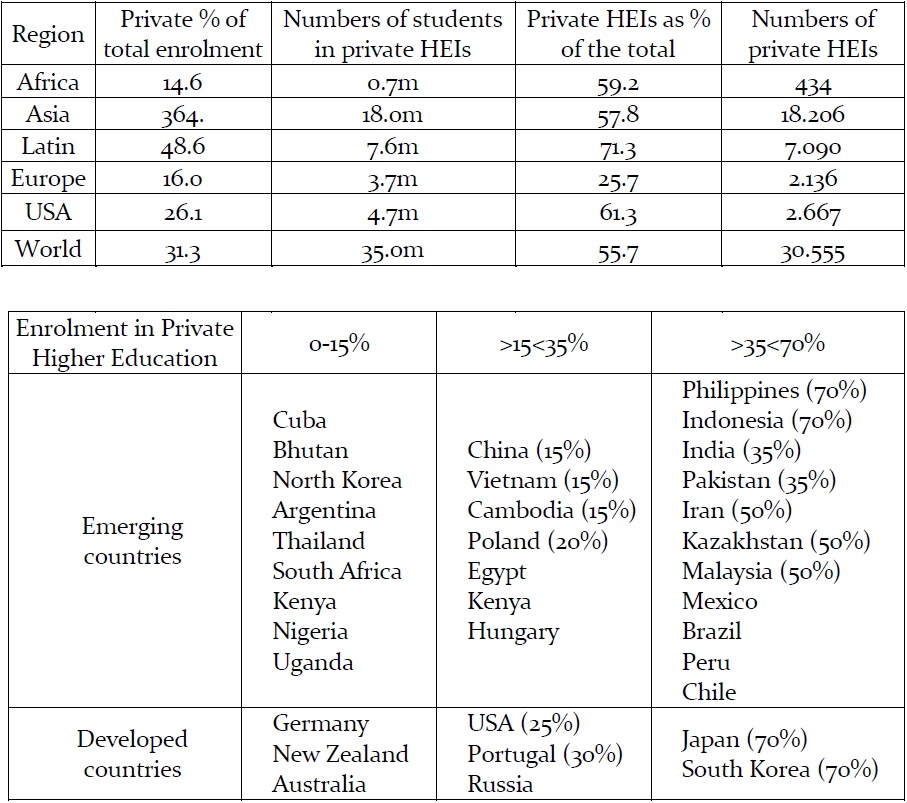
Enrolments in private higher education institutions
4. As nations pursue competitive advantage, the mangers of public research funds may trod the slippery path of restrictive policies which affect the exchange of knowledge, collaborations and partnerships, and speed and smooth functioning of full value chain of innovation.
5. Over the years the absolute sums invested by countries for facilitating innovation has grown to be substantial amounts. As bulk of the public research funds are generated from taxes, there will be a growing tendency for greater accountability. This often leads to cumbersome and time intensive procedures and approval processes, and short term goals driving the agenda. Fine balance is needed for effective management of R&D and yielding desired results over a long period.
1. A few leading Asian nations namely Japan, South Korea and Singapore are investing in R&D in the range of 3% to 3.5% of GDP. The R&D investments of several Asian nations are far below these desired levels. Further efforts are needed by the policy makers as well as the businesses to enhance the innovation capacity and capabilities.
2. Bulk of the R&D investments in Asia is coming from the public funds. Businesses need to be encouraged and incentivized to increase their investments and participation in innovation. 1/3 and 2/3 rule may be worth aiming for in Asia too, i.e., 1/3 of total R&D investments in a country coming the public funds while 2/3 portion coming from the private sector.
3. There is on-going passionate debate worldwide on the wise use of limited public funds for supporting research. Scientific research endeavours have been broadly categorised into a) basic research or curiosity driven intellectual pursuits to generate new knowledge for the sake of knowledge; b) user inspired or applied research; c) research work to support policies, and d) developmental work in support of enterprise (see Figure 5). There is no general consensus on what proportion of public funds to be invested in a specific category. Some feel that small nations and developing nations cannot afford basic research and they are better off focusing on other categories of research and innovation. Large nations and developed nations are expected to support all categories of research endeavours. As the specific context of each nation is different from others it is helpful for the Asian nations to follow 1/3 and 2/3 general rule in apportioning public research funds - 1/3 of total public R&D investments to facilitate basic research while 2/3 portion to support other categories of research and innovation.
4. Over the years the university research has become a key source of innovation for businesses (see Figure 6). According to various global ranking of universities, Asia’s research intensive universities are far behind the leading research intensive universities in academic super power nations such as USA, UK, and Germany. Asian countries need to invest more and engage respective universities in the overall chain of innovation.
5. Private higher education institutions can be more flexible in partnering with businesses creatively and train human capital in niche areas particularly suited for the value chain of innovation. Hence policies should be fine-tuned to maximise the potential of private higher education institutions.
6. Value chain of innovation requires human capital trained differently. Hence higher education sector needs to diversify with critical mass of research-intensive & world-class; industry oriented; and teaching focused universities.
7. Increasing investments in scientific research and innovation alone will not guarantee success. Pioneer of mobile phones, Nokia spent $40 billion on research and development over the past decade- nearly four times what Apple spent in the same period. Despite higher R&D spending (nearly 30% of total R&D spending of mobile phone industry) Nokia fell behind in the market share to competitors Apple and Samsung. Reasons cited include fragmented research efforts due to internal rivalries and politics, disconnect from the operations which brought the phones to the market, and pursuit of wrong strategies. Research in Motion Limited, the promoter of Blackberry, is also struggling to adapt to the market shifts. Impact of innovations is realised when coherent and consistent strategies are executed well.
8. Singapore leads Asia in Global Innovation Index put together by Alcatel-Lucent, Booz & Company, the Confederation of Indian Industry, and the World Intellectual Property Organization. This is an outcome of various proactive schemes and coordinated efforts to facilitate innovation in Singapore. For example a sum of S$360 million has been allocated for the period 2008-2012 to fund initiatives under the National Framework for Innovation and Enterprise (NFIE). Initiatives were aimed at Establishing Support for Academic Entre-preneurship in Universities; Creating Enterprise Support Structures; Enhancing Technology Transfer; and Supporting Innovation Policy Studies.
9. Internationalization of higher learning, research and innovation is the way forward for accelerating innovation and to leverage on other resources. One form of internationalization is at home by bringing in global expertise. Other form of internationalization is taking the local expertise to abroad and exposing them to different ecosystems. Both forms of internationalization can be realised through strategic partnerships.
10. Universities around the world more or less modelled their intellectual property (IP) rules and guidelines based on typical practices of US universities. University owns the intellectual property generated by its researchers, and university technology licensing office (TLO) manages the IP. On average only about two percent of university-generated IP are exploited commercially. There are several valid reasons for such low performance. It is perhaps worth considering certain aspects for more effective outcomes- a) recognize that inventors know the invention better than opaque IP managers, b) inventors own the IP, c) inventors be given support to make right decision in protecting and exploiting respective IPs with suitable businesses, and d) countries and universities to adopt proactive policies to facilitate test bedding of their inventors IPs while leveraging on benefits from successful exploitation of IPs.
11. Open access publishing is gaining momentum with major public research funding organizations in USA, UK and Europe pushing for it. Asian countries are yet to make clear moves on open access publishing. Open access publishing is set to accelerate the process of knowledge dissemination and further widen the fabric of innovation worldwide.
12. This is an opportune time to promote close interactions among various national research funding organizations. Since societal challenges such as clean water, energy & environment, digital security, and affordable healthcare & food are common to most nations, it also worthwhile to consider establishing a Global Research Foundation to accelerate the innovations by drawing on expertise distributed globally for ensuring sustained well-being of humans.
The generations born in 1950s, 60s, and 70s felt that they could not find suitable opportunities in Asia to pursue their interest in innovation career and contribute to the respective societies. This is no longer the same for the next generations of Asia. Asia is becoming a stronghold for innovation careers along with its resurgence in economic, political, and cultural arenas. This transformation happened on the backdrop of growing enrolments in higher education, increasing investments in scientific research & innovation, and innovation supportive policy measures by several Asian countries. Research and Development (R&D) and product customization centres of multinational corporations (MNCs) sited in emerging nations are also instrumental in this transformation.
Innovation is critical to driving growth in developed as well as emerging economies. Opportunities for innovation careers in Asia are not uniform. The value chain of innovation should be further enhanced by internationalization, strategic partnerships, appropriate funding support, and fine tuning of national and organizational policies and systems.
